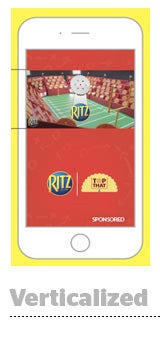 Snapchat’s 10 billion daily video views can’t be wrong.
Snapchat’s 10 billion daily video views can’t be wrong.
At least, that’s publishers’ logic as they push vertical video.
Hearst, for instance, rolled out a vertical video unit last month that it sells via direct deals with advertisers, and on Monday, outstream video company Virool launched a vertical video format called Vertical Reveal, which exchange partner Rubicon Project is starting to deliver to publishers. Clients like The Daily Dot are evaluating it.
Hearst’s rationale is that media properties like Cosmopolitan already had vibrant Snapchat Discover presences.
“We saw positive results in engagement and wanted to make life easier for advertisers, so that, when a customer was looking to do so, we could easily extend a campaign from Cosmopolitan’s Snapchat channel onto Cosmopolitan.com and deliver a similar experience on both platforms,” Todd Haskell, CRO of Hearst Magazines Digital Media, told AdExchanger.
Although he declined to share the CPM range for Hearst’s vertical video ads, Haskell said Hearst sees the vertical video experience as a premium product, whether it’s a half-page unit either on-site or on mobile, similar to how it considers its brands’ presences on Snapchat.
Meanwhile, The Daily Dot typically avoided pre-roll because it was interested in growing its video audience before it considered monetization.
The Daily Dot first worked with Virool about nine months ago when it included outstream video – a format typically assimilated into article content for more of a native experience – as part of a direct campaign.
“After we completed that direct campaign, we wanted to leverage some programmatic fill, which we did as well through Virool and have been testing ever since,” said Mike Foley, director of programmatic for The Daily Dot. “We’re definitely interested in [Vertical Reveal] and will be testing it out in the coming weeks and months.”
Snapchat Conditioned The Consumer
Traditionally, advertisers, creatives and audiences decried the vertical video format, preferring the more viewer-centric landscape mode.
AdExchanger Daily
Get our editors’ roundup delivered to your inbox every weekday.
Daily Roundup
But support for vertical video is growing. Besides Snapchat, Hearst and Virool, big video platforms like YouTube are adding support for vertical videos in full-screen portrait mode.
And with 62% of advertisers planning to increase their mobile video budgets this year, according to the 2016 IAB Video Ad Spend study, publisher adoption of mobile outstream and vertical formats could increase as well.
But even with these changes, there are few places where vertical video ads can actually be distributed outside of Snapchat. Even with massive view counts, some advertisers want better analytics and targeting.
“If you’re an advertiser, you’re trying to reach people on their phones,” said Alex Debelov, CEO of Virool. “We didn’t want them to just be constrained to creating this video content only for Snapchat or for Facebook, but to be able to show their videos on Mashable, The Daily Dot and other top sites.”
Selling Vertical
For now, a lot of outstream and vertical video ads are sold direct, but with Virool’s partnership with Rubicon, the formats will eventually scale in the exchange environment, in the same way its predecessor pre-roll did.
“We only have a few handful of Deal ID-enabled deals right now, but almost every single trade desk, agency or buying team I’m talking to is very interested in outstream, and it will seemingly get there sooner or later,” Foley added. “Everybody has video, and they’re all trying to find some place to distribute it, so it seems like a no brainer,” for the publisher to experiment with vertical video as it did with sister outstream formats.
Right now, there is no RTB spec for vertical video formats, though video ad servers and supply side platforms like Beachfront are enabling publishers to serve these ads directly. Still, there is some disparity between publisher and advertiser demand and the creative requirements of vertical video.
“You’re still in a video ad space where people are pushing 30- and 15-second TV ads onto mobile devices, and now you’re talking vertical video ads?” said Frank Sinton, CEO of the video SSP Beachfront. “The challenge is, you have to shoot the video vertically, and advertisers generally don’t want to buy mobile web autoplay.” [See AdExchanger’s coverage on the buy side’s view on outstream.]
Unsurprisingly, publishers want to sell more mobile formats like vertical video and outstream video ads in a meaningful way, to monetize video around the pre-roll shortage. According to Foley, The Daily Dot’s traffic is now 60-plus percent mobile, so it’s figuring out how to monetize that many mobile impressions in a smart way.
Because they can claim higher rates of viewability and engagement for these video units, vertical and outstream video providers like Virool can charge well north of $20 CPMs, with vertical videos commanding similar prices.
“For advertisers looking to reach a millennial audience, they recognize that they should do so in a manner that will drive the strongest engagement,” Hearst’s Haskell said. “For millennials who are mainly consuming content via a mobile device, that is very clearly vertical. The adoption with brands won’t happen overnight, but we’re seeing it evolve very quickly.”














